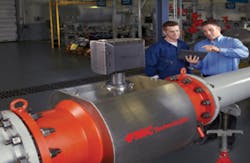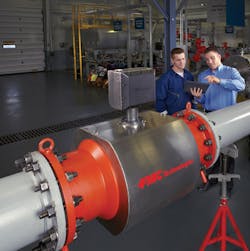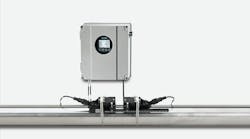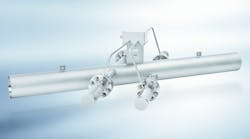To determine the velocity profile more accurately, custody-transfer ultrasonic flowmeters use multiple sets of transducers on chordal paths. The multiple chordal paths help in detecting whether the flow is laminar, transitional or turbulent. The number of paths, their location, and the algorithms that integrate the path velocities into an average velocity all contribute to the meter’s accuracy.(Photo courtesy of FMC Technologies)
Growth in the energy markets is a major factor driving growth in the ultrasonic flowmeter market. Natural gas is increasingly seen as a cleaner alternative to oil and petroleum liquids. It is also being positioned as a long-term bridge to renewables. Ultrasonic flowmeters are ideal for pipeline applications involving custody transfer of natural gas. Here they compete with differential-pressure (DP) and turbine flowmeters. However, ultrasonic meters have distinct advantages over the competition, since they have no moving parts and are extremely reliable. The need for gas flow measurement can only increase as the need for energy increases. Ultrasonic flowmeters are also widely used to measure petroleum and non-petroleum liquids.
According to a recent series of studies from Flow Research, the market for ultrasonic meters totaled $756 million in 2013, and is projected to grow at a compound annual growth rate of 9 percent through 2018. Inline ultrasonic meters account for two-thirds of revenues, with the remainder divided between clamp-on and insertion meters.
READ ALSO:
- Energy and Large-Pipe Applications Drive Coriolis Technology to New Heights
- Differential Pressure Maintains a Powerful Place in the World of Flow Measurement
- Magmeters Top the Flowmeter Market In Revenue
- PD Flowmeters Poised to Gain from Oil & Gas Application Opportunities
- Emissions Monitoring Applications Propel Thermal Flowmeter Market
- Turbine Flowmeters Remain Competitive in Turbulent Market
- Vortex Flowmeters Prove Their Worth In Steam Flow Measurement
Flowmeter manufacturers are focusing a great deal of attention on ultrasonic flowmeters. Much of their research and development efforts are currently going into these meters, perhaps at the expense of other meters such as vortex and turbine. Suppliers have made significant progress in enhancing the accuracy and reliability of ultrasonic flowmeters, mainly by increasing the number of paths, thereby increasing the number of measurement points, and also by adding greater diagnostic capability. The enhanced diagnostic capability can reduce the need for upstream piping, and also increases the ability of the ultrasonic meter to determine sources of error. Lately, new and more accurate meters have been developed for custody transfer of petroleum liquids as well as for custody transfer of natural gas.
Ultrasonic flowmeters are also being more widely used to measure process gas and flare gas. The use of ultrasonic meters for gas flow measurement has evolved substantially from the late 1970s and early 1980s, when this type of measurement was first attempted. The use of wetted sensors provides greater accuracy. Insertion meters are used to measure flare gas in stacks, and ultrasonic flowmeters are used more widely in the chemical and refining industries. While the growth of ultrasonic meters to measure process and flare gases is not as rapid as is the growth of multipath meters for custody transfer of natural gas, it is still an important factor in the overall growth of the ultrasonic flowmeter market.
The development of multipath transit-time flowmeters, which use more than one ultrasonic signal or “path” in calculating flowrate, has been important for ultrasonic flowmeters. Each path requires a pair of sending and receiving transducers. By using more than one path, the flowmeter measures flow at more than one location in the flowstream, leading to greater accuracy. Multipath flowmeters have been especially important in the use of transit-time meters to measure natural gas flow. In June 1998, the American Gas Association approved the use of multipath ultrasonic flowmeters for custody transfer of natural gas applications. Since that time, there has been a substantial increase in the use of these meters for natural gas measurement, especially for custody transfer.
For more information on ultrasonic flowmeters, visit www.flowultrasonic.com.



